On this page
- 1.0 Purpose
- 2.0 Authorities
- 3.0 Reference documents
- 4.0 Definitions
- 5.0 Acronyms
- 6.0 Operational guideline
- 7.0 Appendices
1.0 Purpose
The purpose of this document is to provide guidance to Canadian Food Inspection Agency (CFIA) Inspection Staff on specified risk material (SRM) controls at licensed federal meat establishments
This document is intended to be used in conjunction with other guidance documents such as Policy and Programs Branch (PPB) document: Guidance on Specified risk material and Standard Inspection Procedures, referenced in Section 3.0
The guidance outlined below should be used when conducting inspections to ensure removal of specified risk material (SRM) from edible meat, prevention of cross-contamination to edible meat products by SRM during slaughter and cutting / boning operations and when monitoring enhanced feed ban controls.
The guidance is designed to meet the following objectives:
- to ensure removal of all specified risk materials (SRM); and
- to prevent cross contamination of edible meat products by SRM during slaughter and cutting/boning operations
- To prevent SRM cross contamination of inedible material destined for the production of animal feed, pet food and fertilizer
2.0 Authorities
- Health of Animals Act
- Health of Animals Regulations
- Safe Food for Canadians Act
- Safe Food for Canadians Regulations
- Food and Drugs Act
- Food and Drugs Regulations
- The inspection powers, control actions and enforcement actions authorized by the above legislation are identified and explained in the Operational guideline : Food regulatory response guidelines.
3.0 Reference documents
- Operational guideline : Food regulatory response guidelines
- Standard inspection procedure
- Technical reference - Guidance on Specified risk material
4.0 Definitions
Unless specified below, definitions are located in either the:
- Safe Food for Canadians Regulations: Glossary of Key Terms
- Integrated Agency Inspection Model (iAIM) - Glossary of Terms (Annex F) (internal access only – RDIMS 4948288)
- My CFIA Glossary of Terms
- Cattle
- animals of the species Bos taurus or Bos indicus; but does not include other ruminants such as bison, muskox, yak or water buffalo.
- Licenced establishment
- an establishment licenced under the Safe Food for Canadians Act
- Specified Risk Materials (SRM)
- Means the skull, brain, trigeminal ganglia, eyes, palatine tonsils, spinal cord and dorsal root ganglia (DRG) of cattle aged 30 months or older, as well as the distal ileum of cattle of all ages.
Note
The brain, trigeminal ganglia, eyes, palatine tonsils, spinal cord, dorsal root ganglia and distal ileum are designated as SRM because, in Bovine Spongiform Encephalopathy (BSE) infected cattle, these tissues contain the BSE agent and may transmit the disease. The OTM skull (excluding the mandible, horns and cranial cap) is designated as well because of the high probability of it becoming contaminated at the time of stunning and during manipulation of the other tissues if their separate removal was permitted.
5.0 Acronyms
Acronyms are spelled out the first time they are used and are consolidated in the Food business line acronyms list (internal access only – RDIMS 10660735).
- CFIA
- Canadian Food Inspection Agency
- CVS
- Compliance Verification System
- DRG
- Dorsal root ganglia
- IIC
- Inspector in Charge
- HACCP
- Hazard Analysis Critical Control Points
- MAPAQ
- Ministère de l'Agriculture, des Pêcheries et de l'Alimentation du Québec
- OTM
- Over Thirty Month (cattle that are thirty months of age and older)
- PCPs
- Preventative Control Plans
- PPB
- Policy and Programs Branch
- RVO
- Regional Veterinary Officer
- SRM
- Specified Risk Material
- UTM
- Under Thirty Month (cattle that are under thirty months of age)
6.0 Operational guideline
Part I: Removal of Specified risk material (SRM)
6.1.0 Introduction
Every licence holder involved in the slaughter of cattle and/or the cutting/boning of cattle carcasses/quarters, should implement the practices described on PPB reference document: Guidance on Specified risk material.
6.1.1 Regulatory basis
See PPB reference document: Guidance on Specified risk material.
6.1.2 Preventative Control Plans
Requirements for Preventative Control Plans (PCPs) are outlined on PPB document: Guidance on Specified risk material. Preventative Control Plans are to be reviewed and approved by the Veterinarian with supervisory authority or Inspector In-Charge (IIC) as is appropriate and their implementation must demonstrate ongoing and effective control, including but not limited to, control over animal identification and aging, cattle that are thirty months of age and older (OTM) carcass identification and marking, SRM removal and OTM carcass segregation. Integrated Agency Inspection Model Section 3 and Annex B should be consulted for details on how to review and approve PCPs; Integrated Agency Inspection Model (iAIM) (internal access only – RDIMS 4948288). If these requirements are not fully met by the license holder, the Veterinarian with supervisory authority or IIC will review the situation and will take appropriate compliance action.
6.2.0 Cattle identification, age determination, marking and segregation of carcasses upon arrival and during slaughter / dressing, chilling, cutting and boning procedures
License holders slaughtering or cutting/deboning cattle under 30 months (UTM) and OTM cattle must establish and implement procedures for identifying and separating these two types of cattle as described on PPB document: Guidance on Specified risk material. Alternative procedures that assure, with equal confidence, maintenance of the identity of the carcass and all its parts until their final disposition is known, may be approved by the Veterinarian with supervisory authority.
6.2.1 Age determination, identification and marking of carcasses
Age determination, identification and marking of carcasses requirements are outlined on PPB reference document: Guidance on Specified risk material. CFIA Inspectors are to audit the license holder's PCPs as outlined on Annex C of the Integrated Agency Inspection Model (iAIM) (internal access only – RDIMS 4948288) .
Determining age by birth date documentation
Acceptable methods for determining the age of an animal by birth date documentation are outlined on PPB reference document: Guidance on Specified risk material.
As part of ante mortem inspection procedures, CFIA inspectors will examine birth date documentation used by the license holder for determining the age of cattle. If the Veterinarian with supervisory authority concludes that the document is accurate and reliable, the document will be accepted as verification of the age of the cattle. However, if the Veterinarian with supervisory authority finds significant reasons for questioning the validity of the document, the cattle in question will be processed as a lot and the document will be further verified in consultation with the original issuing authority. If verified by the issuing authority, the lot is released. If the lot cannot be verified by the issuing authority, then dentition will be used for age determination. If considered appropriate, an observation report will be forwarded by the Veterinarian with supervisory authority to the Area CFIA individual responsible for identification and traceability for possible follow-up actions on a case by case basis.
Similarly if an animal's birth date documentation has been deemed acceptable on ante mortem inspection but at head inspection by the CFIA, a head is observed where the fifth permanent incisor tooth is above the gum line, the animal will be deemed an OTM and will be treated accordingly. The inspector will note the discrepancy between birth date documentation and physical appearance of the head as a deviation. If considered appropriate, an observation report will be forwarded by the Veterinarian with supervisory authority to the Area CFIA individual responsible for identification and traceability. This would flag clusters of improper age determination/identification by producers and allows for follow-up actions on a case by case basis. Traceability National Information Portal is a resource for inspection staff for age verification.
Loss of identification or no identification will result in the animal being aged by its dentition.
Determining age by dentition examination when no birth date documentation is provided
PPB reference document: Guidance on Specified risk material, describes the determination of age by dentition examination when no birth date documentation is provided.
Visual examination of the incisor teeth of each carcass must occur at or before the head inspection station.
CFIA inspectors are to verify the effectiveness and accuracy of age determination performed by the license holder by examining the incisor teeth of all carcasses of cattle during the inspection of the head. See Appendix A of this document for diagrams of cattle incisor teeth and the corresponding age. The inspector is to record errors in age determination by plant personnel and immediately notify the license holder for implementation of appropriate corrective and preventive actions.
Identification and marking of carcasses
The identification and marking of carcasses of OTM animals is described on PPB reference document: Guidance on Specified risk material.
Control and identity of the carcass, head and parts must be maintained. The head is identified as OTM by means acceptable to the Veterinarian with supervisory authority.
Application of the blue ink described on PPB reference document: Guidance on Specified risk material to the vertebrae shortly after the carcass has exited the carcass wash, must only occur when the license holder has a written program in place which has been approved by the Veterinarian with supervisory authority that can demonstrate ongoing effective controls, including a carcass identification and marking system that will ensure all OTM carcasses are properly identified and marked. See Appendix D of this document for marks that are to be applied.
6.2.2 Control and segregation of carcasses during dressing, chilling, cutting and boning procedures
Slaughter Establishments
Control and segregation of carcasses during dressing, chilling, cutting and boning requirements for license holders is described on PPB reference document: Guidance on Specified risk material.
If a license holder chooses to slaughter and segregate OTM cattle using alternative methodology, a written control program, that is able to achieve the same outcome, must be reviewed and found acceptable to the Veterinarian with supervisory authority prior to implementation. The license holder is responsible to ensure that the proposed segregation method meets all eligible export requirements.
Cutting / boning establishments
PPB reference document: Guidance on Specified risk material outlines requirements for cutting/deboning establishments that receive sides and/or quarters of OTM cattle.
6.3.0 Stunning, dressing, boning and SRM removal
6.3.1 Dedicated SRM tools
See PPB reference document: Guidance on Specified risk material.
6.3.2 Stunning
Three acceptable methods are described on PPB reference document: Guidance on Specified risk material, for the prevention of SRM cross-contamination of cattle blood that may be used in feeds and food of animals. Any other method other than as described has to be approved by CFIA. For more details on approval process see Blood collection during slaughter.
The policy on prevention of cross contamination of under thirty month old (UTM) cattle carcasses with SRM by the slaughter / processing of incidental over thirty month old (OTM) cattle in abattoirs should be followed, for more details: Incidental OTM cattle stunning and contamination with specified risk material (SRM) in slaughter of UTM cattle
PPB reference document: Guidance on Specified risk material includes reference tables for disposition of face plates, head hides from cattle.
6.3.3 Head separation and removal of skull, brain, trigeminal ganglia, eyes and tonsils
See PPB reference document: Guidance on Specified risk material.
6.3.4 Palatine tonsils
See PPB reference document: Guidance on Specified risk material.
6.3.5 Tongue and cheek meat
See PPB reference document: Guidance on Specified risk material.
6.3.6 Removal of the distal ileum
PPB reference document: Guidance on Specified risk material, outlines two options for the removal of the distal ileum; the second option does not involve the removal and disposal of all cattle small intestines as SRM. Prior to implementation of the second option as described, a control program must be developed, implemented and maintained. This control program has to be reviewed and found acceptable by the Veterinarian with supervisory authority. See Appendix C of this document for a diagram of the cattle gastrointestinal tract)
6.3.7 Carcass splitting
See PPB reference document: Guidance on Specified risk material.
6.3.8 Removal of the spinal cord and its verification
See PPB reference document: Guidance on Specified risk material.
See Appendix B of this document for diagrams of cattle vertebral column.
6.3.9 Removal of the dorsal root ganglia (DRG)
See PPB reference document: Guidance on Specified risk material.
Slaughter / shipping establishments
Slaughter establishments that do not remove DRG from vertebral columns on-site will have to implement identification and shipping control system satisfactory to the Veterinarian with supervisory authority as outlined on PPB reference document: Guidance on Specified risk material.
CFIA officials will be responsible for verifying the license holder's compliance using the corresponding Compliance Verification System (CVS) tasks.
Receiving establishments
See PPB document: Guidance on Specified risk material.
Receiving establishment must have a CFIA permit to receive carcasses containing SRM. The receiving establishment must have a verifiable control system in place which will demonstrate to the satisfaction of the CFIA that sections of the vertebral column containing DRG are removed and appropriately disposed of as SRM. CFIA officials will be responsible to verify the license holder's compliance using the corresponding CVS tasks.
6.3.10 Verification by the licence holder of SRM removal and rework
See PPB reference document: Guidance on Specified risk material.
6.4.0 SRM handling and disposition
See PPB reference document: Guidance on Specified risk material.
6.4.1 Handling of SRM within the Establishment
See PPB reference document: Guidance on Specified risk material.
6.4.2 Floor waste
See PPB reference document: Guidance on Specified risk material.
The license holder should have a written program in place, to the satisfaction of the Veterinarian with supervisory authority with consultation of the Regional Veterinary Officer (RVO), to prevent the cross-contamination of floor from SRM tissues in these specific areas.
6.4.3 SRM containers
See PPB reference document: Guidance on Specified risk material.
6.4.4 Cleaning of SRM containers
See PPB reference document: Guidance on Specified risk material.
6.5.0 SRM controls
CFIA staff shall verify the license holder's full compliance with all relevant regulations and the guidance on PPB reference document: Guidance on Specified risk material through the completion of relevant inspection tasks and audits.
PART II: Enhanced feed ban controls and SRM management
6.6.0 Introduction
See PPB reference document: Guidance on Specified risk material.
6.6.1 Policy objectives
See PPB reference document: Guidance on Specified risk material.
6.6.2 Control programs
Control programs described on PPB reference document: Guidance on Specified risk material are to be reviewed and approved by the Veterinarian with supervisory authority or Inspector In-Charge (IIC) as is appropriate and their implementation must demonstrate ongoing and effective controls over SRM segregation, staining, shipping/ transportation, record keeping and compliance with the CFIA SRM permitting process. Integrated Agency Inspection Model Section 3 and Annex B should be consulted for details on how to review and approve Preventative Control Plans (PCPs) Integrated Agency Inspection Model (iAIM) (internal access only – RDIMS 4948288). If these requirements are not fully met by the license holder, the Veterinarian with supervisory authority or IIC will assess the situation and will take appropriate compliance action.
6.7.0 Collection, segregation and staining of SRM
6.7.1 Specified risk material (SRM)
See PPB reference document: Guidance on Specified risk material.
SRM removed from cattle carcasses
See PPB reference document: Guidance on Specified risk material.
Animals condemned at ante mortem, post mortem, deadstock and cattle foetuses
See PPB reference document: Guidance on Specified risk material.
Floor waste
See PPB reference document: Guidance on Specified risk material.
Where there are effective controls to prevent floor from contact with SRM, floor waste and debris collected from the corresponding drain covers and traps do not need to be disposed of as SRM. The license holder should have a written program in place, to the satisfaction of the Veterinarian with supervisory authority with consultation of the Area and Regional Veterinarian Officer (RVO), to prevent the cross-contamination of floor from SRM tissues in these specific areas.
Waterwaste materials
See PPB reference document: Guidance on Specified risk material.
License holders who wish to exempt the materials and debris recovered from the wastewater derived from the slaughter floor as SRM must have a written program in place to the satisfaction of the Veterinarian with supervisory authority with consultation of the Area and the Regional Veterinary Officer (RVO).
6.7.2 SRM containers
See PPB reference document: Guidance on Specified risk material.
6.7.3 Segregation and staining of SRM
See PPB reference document: Guidance on Specified risk material.
6.8.0 Shipping of SRM from the establishment
6.8.1 Shipping of SRM from the inedible area of the establishment
See PPB reference document: Guidance on Specified risk material.
The responsible CFIA Inspector will verify the license holder's control program described in this section.
6.8.2 Shipping of OTM carcasses containing DRG
Slaughter / shipping establishments
See PPB reference document: Guidance on Specified risk material.
OTM carcass transporters
See PPB reference document: Guidance on Specified risk material.
Receiving establishments
See PPB reference document: Guidance on Specified risk material.
6.8.3 On-site disposal
See PPB reference document: Guidance on Specified risk material.
6.9.0 Record keeping
SRM records required by the Health of Animals Regulations
See PPB reference document: Guidance on Specified risk material.
6.10.0 Compliance and verification
License holder's responsibilities
See PPB reference document: Guidance on Specified risk material.
The license holder's SRM control programs must be auditable and verifiable to the satisfaction of the CFIA officials.
CFIA inspection staff's responsibilities
CFIA staff shall verify the license holder's full compliance with all relevant regulations, PPB Guidance on Specified risk material and this operational guidance through the completion of relevant inspection tasks and audits.
CFIA inspection staff shall oversee the removal, segregation, handling and staining of SRM (including deadstock or condemned carcasses from which SRM has not been removed), compliance to permit conditions and record keeping at licensed establishments. CFIA inspection staff shall take appropriate enforcement action when non-compliant situations are detected.
7.0 Appendices
For general inquiries related to this Operational Guidance Document, please follow established communication channels, including submitting an electronic Request for Action Form (e-RAF).
Appendix A: Cattle Dentition
Figure I: Permanent Teeth Lingual Aspect Incisor and Canine Teeth of Ox 5 Years of Age
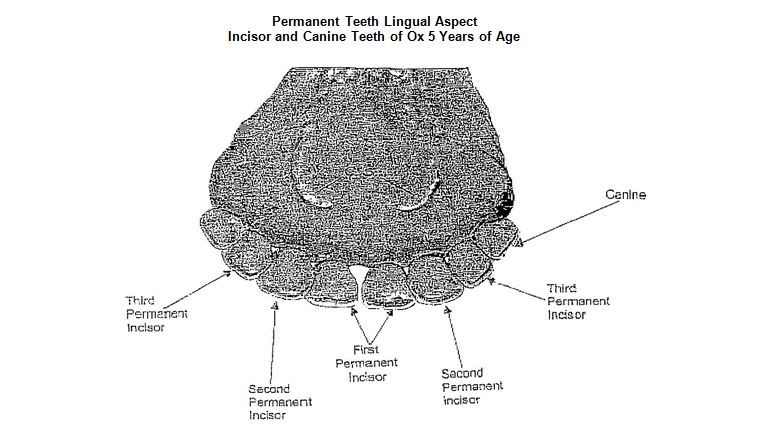
Description for Figure I - Permanent Teeth Lingual Aspect, Incisor and Canine Teeth of Ox 5 Years of Age
The figure represents the lingual aspect of the mandible of a bovine of 5 years of age. The first permanent incisors (left and right) are located centrally, the second permanent incisors (left and right), the third permanent incisors (left and right) and the right canine, respectively located laterally, are identified.
Extracted from: Sisson and Grossman's: The Anatomy of the Domestic Animals - Volume 1
Figure II: Dentition for Cattle
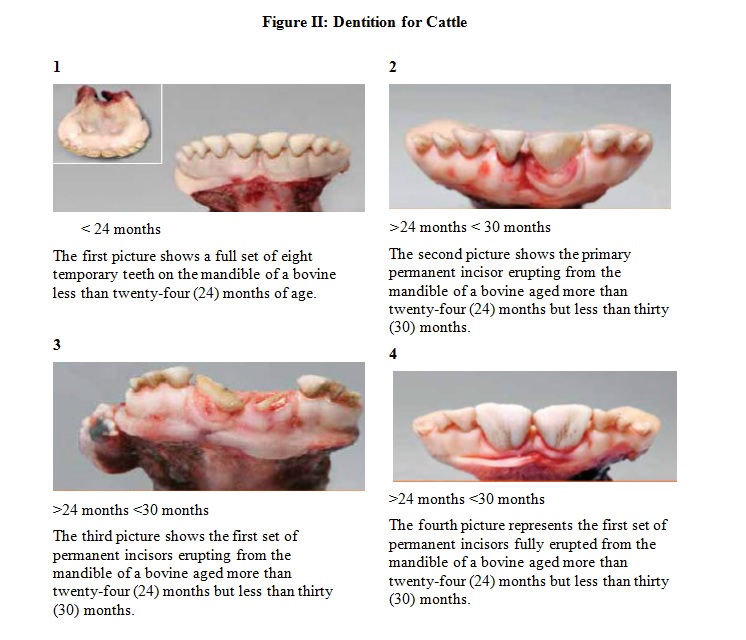
Description for II: Dentition for Cattle (1 to 4)
- < 24 months The first picture shows a full set of eight temporary teeth on the mandible of a bovine less than twenty-four (24) months of age.
- >24 months < 30 months The second picture shows the primary permanent incisor erupting from the mandible of a bovine aged more than twenty-four (24) months but less than thirty (30) months.
- >24 months <30 months The third picture shows the first set of permanent incisors erupting from the mandible of a bovine aged more than twenty-four (24) months but less than thirty (30) months.
- >24 months <30 months The fourth picture represents the first set of permanent incisors fully erupted from the mandible of a bovine aged more than twenty-four (24) months but less than thirty (30) months.

Description for II: Dentition for Cattle (5 to 8)
5. >30 months The fifth picture represents three permanent incisors fully erupted from the mandible of a bovine aged more than thirty (30) months.
6. >30 months The sixth picture shows second pair of permanent incisors erupting from the mandible of a bovine aged more than thirty (30) months.
7. >30 months The seventh picture shows two pairs of permanent incisors completely erupted from the mandible of a bovine aged more than thirty (30) months.
8. >30 months The eighth and last picture shows a full set of permanent incisors in a bovine aged more than thirty (30) months.
Pictures used with permission of Ministère de l'Agriculture, des Pêcheries et de l'Alimentation du Québec (MAPAQ)
Appendix B: Cattle Vertebral Column

Description for image – Cattle vertebral column, Ruminant
The left figure represents the dorsal view of a bovine dura mater enclosed spinal cord.
Are identified:
- Number 1 is the wing of the first cervical vertebra.
- Number 2 is the eighth cervical spinal nerve exiting through the intervertebral foramen.
- Number 3 is the fourth thoracic spinal nerve exiting through the lateral vertebral foramen.
- Number 4 is the tenth thoracic rib.
The right figure represents the bovine caudal thoracic, lumbar, sacral and caudal dura mater enclosed spinal cord. The sacrum is identified.
Are identified:
- Number is the thirteenth thoracic spinal nerve.
- Number 2 is the transverse process of a third lumbar vertebra.
- Number 3 is the sixth lumbar spinal nerve.
- Number 4 is the fifth sacral spinal nerve.
- Number 5 is the second caudal (coccygeal) vertebra.
Extracted from: Sisson and Grossman: The Anatomy of the Domestic Animals - Volume 1
Figure II: Cattle lumbar vertebra
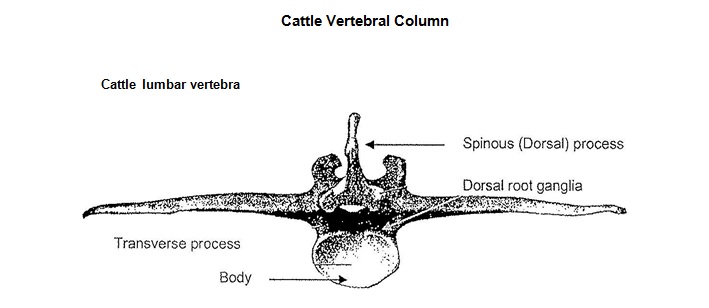
Description for image - Bovine lumbar vertebra
This figure represents a frontal view of a bovine lumbar vertebra. The body, transverse process, dorsal root ganglia and spinous (dorsal) process are identified.

Description for image - Bovine cervical vertebra
This figure represents a frontal view of a bovine cervical vertebra. The body, transverse process, dorsal root ganglia and spinous (dorsal) process are identified.
Note
The Dorsal Root Ganglia may protrude from the intervertebral foramen into the space that lies between the body and transverse processes of adjoining vertebrae. The ribs are attached to shortened transverse processes in the thoracic region.
Extracted from: Sisson and Grossman The Anatomy of the Domestic Animals - Volume 1
Figure III : Cattle sacrum
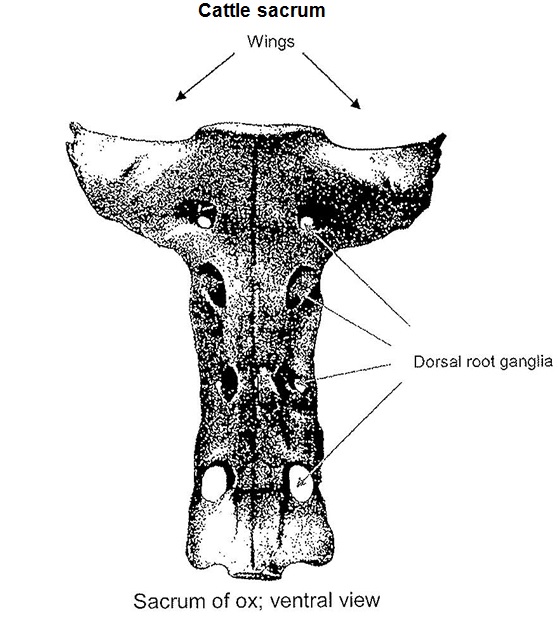
Description for image - Bovine sacrum, ventral view
Bovine sacrum, ventral view This figure represents the ventral view of the sacrum of a bovine. Four arrows indicate the location of the dorsal root ganglia. The left and right wings of the bovine sacrum are identified.

Description for image - Bovine sacrum, dorsal view
Bovine sacrum, dorsal view This figure represents a dorsal view of the sacrum of a bovine. No structures are identified on this figure.
Extracted from: Sisson and Grossman: The Anatomy of the Domestic Animals - Volume 1
Appendix C - Cattle Gastrointestinal Tract

Description for image – Cattle Gastrointestinal Tract
- Stomach
- Small intestine
- Cecum
- Ascending colon
- Descending colon
Extracted from: Dyce, Sack and Wensing Textbook of Veterinary Anatomy, 3rd edition
Appendix D: Identifying Marks, Carcass of Cattle Aged 30 Months or Older
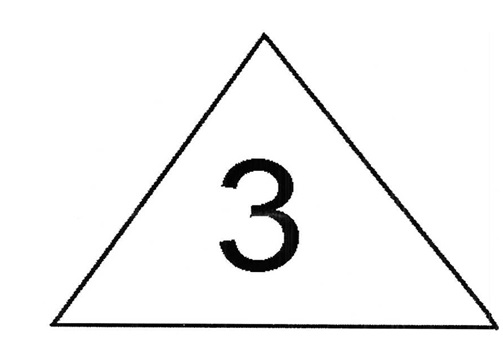
Description of image - Identifying Marks: Carcass of cattle aged 30 months or older
This figure represents an equilateral triangle with a number 3 inside.
or
